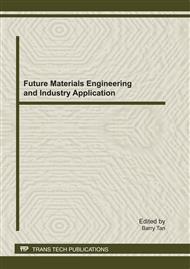[1]
A. Alonso and J. A. Camargo, Toxicity of nitrite to three species of freshwater invertebrates, Environ Toxicol, vol. 21, 2006, p.90–94.
DOI: 10.1002/tox.20155
Google Scholar
[2]
J. M. S. van Maanen, I. J. Welle, A. van Dijk, G. Hageman, J. W. Dallinga, and J. C. S. Kleinjans, Nitrate contamination of drinking water: relationship with HPTR variant frequency in lymphocyte, Mutation Research/ Environmental Mutagenesis and Related Subjects, vol. 360, Aug. 1996, pp.232-233.
DOI: 10.1016/s0165-1161(96)90076-x
Google Scholar
[3]
F. B. Jensen, Nitrite disrupts multiple physiological functions in aquatic animals, Comp Biochem Physiol, vol. 135, 2003, p.9–24.
Google Scholar
[4]
S. H. Lin and C. L. Wu, Electrochemical removal of nitrite and ammonia for aquaculture, Water Res, vol. 30, 1996, p.715–721.
DOI: 10.1016/0043-1354(95)00208-1
Google Scholar
[5]
Y. Nagasaka, New water environmental standards for human health, Environ Management, vol. 35, 1999, p.861–866.
Google Scholar
[6]
J. A. Cole and C. M. Brown, Nitrite reduction to ammonia by fermentative bacteria: a short circuit in the biological nitrogen cycle, FEMS Microbiol. Lett., vol. 7, 1980, pp.65-72.
DOI: 10.1111/j.1574-6941.1980.tb01578.x
Google Scholar
[7]
J. Cole, Nitrate reduction to ammonia by enteric bacteria redundancy, or a strategy for survival during oxygen starvation, FEMS Microbiol. Lett., vol. 136, 1996, pp.1-11.
DOI: 10.1111/j.1574-6968.1996.tb08017.x
Google Scholar
[8]
JonO. Lundberg, E. Weitzberg, Jeff A. Cole, and N. Benjamin, Nitrate, bacteria and human health, Nature reviews, vol. 2, 2004, pp.593-602.
DOI: 10.1038/nrmicro929
Google Scholar
[9]
F. Thalasso, A. Vallecillo, P. Garcia-Encina, and F. Fdz Polanco, The use of methane as a sole carbon source for wastewater denitrification, Water Res., vol. 31, 1997, p.55–66.
DOI: 10.1016/s0043-1354(96)00228-x
Google Scholar
[10]
F. Jeanmougin, Julie D. Thompson, G. Manolo, Desmond G. Higgins, and Toby J. Gibson, Multiple sequence alignment with Clustal X, Trends in Biochemical Sciences, vol. 23, 1998, pp.403-405.
DOI: 10.1016/s0968-0004(98)01285-7
Google Scholar
[11]
S. F. Altschul, T. L. Madden, A. A. Schäffer, J. Zhang, Z. Zhang, W. Miller, and D. J. Lipman, Gapped BLAST and PSI-BLAST: a new generation of protein database search programs, Nucleic Acids Research, vol. 25, 1997, p.3389–3402.
DOI: 10.1093/nar/25.17.3389
Google Scholar
[12]
A. A. Graaf, P. van de Bruijn, L. A. Robertson, M. S. M. Jetten, and J. G. Kuenen, Autotrophic growth of anaerobic, ammonium oxidising microorganisms in a fluidized bed reactor, Microbiology (UK), vol. 142, 1996, p.2187–2196.
DOI: 10.1099/13500872-142-8-2187
Google Scholar
[13]
J. M. Gil and J. L. Serra, Nitrate removal by immobilized cells of Phormidium uncinatum in batch culture and a continuous-flow photobioreactor, Applied Microbiology and Biotechnology, vol. 39, 1993, p.782–787.
DOI: 10.1007/bf00164467
Google Scholar
[14]
D. Lindsay, V. S. Brözel, J. F. Mostert and A. von Holy, Physiology of dairy-associated Bacillus sp. over a wide pH range, International Journal of Food Microbiology, vol. 54, 2000, p.49–62.
DOI: 10.1016/s0168-1605(99)00178-6
Google Scholar
[15]
P. A. S. Motteram, J. E. G. McCarthy, S. J. Ferguson, J. B. Jackson, and J. A. Cole, Energy conservation during formate-dependent reduction of nitrite by Escherichia coli, FEMS Microbiol. Lett., vol. 12, 1981, pp.317-320.
DOI: 10.1111/j.1574-6968.1981.tb07665.x
Google Scholar
[16]
G. J. Mitchell, J. G. Jones, and J. A. Cole, Distribution and regulation of nitrate and nitrite reduction by Desulfovibrio and Desulfotomaculum species, Arch. Microbiol., vol. 144, 1986, pp.35-40.
DOI: 10.1007/bf00454953
Google Scholar
[17]
I. SchrÖ der, A. M. Roberton, M. Bokranz, G. Unden, R. BÖcher, and A. KrÖger, The membraneous nitrite reductase involved in the electron transport of Wolinella succinogenes, Arch. Microbiol., vol. 140, 1985, pp.380-386.
DOI: 10.1007/bf00446982
Google Scholar
[18]
M. RoeMler, X. Sewald, and V. Müller, Chloride dependence of growth in bacteria, FEMS Microbiology Letters., vol. 225, 2003, pp.161-165.
DOI: 10.1016/s0378-1097(03)00509-3
Google Scholar
[19]
C. Moreno-Vivian and S. J. Ferguson, Definition and distinction between assimilatory, dissimilatory and respiratory pathways, Mol. Microbiol., vol. 29, 1998, pp.661-669.
DOI: 10.1046/j.1365-2958.1998.00946.x
Google Scholar
[20]
J. T. Lin and V. Stewart, Nitrate assimilation by bacteria, Adv. Microb. Phys., vol. 39, 1998, pp.1-30.
Google Scholar
[21]
J. Cole, Nitrate reduction to ammonia by enteric bacteria: redundancy, or a strategy for survival during oxygen starvation, FEMS Microbiol. Lett., vol. 136, 1996, pp.1-11.
DOI: 10.1111/j.1574-6968.1996.tb08017.x
Google Scholar
[22]
M. C. Liu, H. D. Peck, A. Abou-Jaoude, M. Chippaux, and J. LeGall, A reappraisal of the role of the low potential c-type cytochrome (cytochrome c-552) in NADH-dependent nitrite reduction and its relationship with a co-purified NADH oxidase in Escherichia coli K-12, FEMS Microbiol. Lett., vol. 10, 1981, pp.333-337.
DOI: 10.1111/j.1574-6968.1981.tb06266.x
Google Scholar
[23]
S. Kajie and Y. Anraku, Purification of a hexaheme cytochrome c552 from Escherichia coli K12 and its properties as a nitrite reductase, Eur. J. Biochem., vol. 154, 1986, pp.457-463.
DOI: 10.1111/j.1432-1033.1986.tb09419.x
Google Scholar
[24]
M. C. Liu and H. D. Peck, The isolation of a hexaheme cytochrome from Desulfovibrio desulfuricans and its identification as a new type of nitrite reductase, J. Biol. Chem., vol. 256, 1981, pp.13159-13164.
DOI: 10.1016/s0021-9258(18)43021-9
Google Scholar
[25]
M. C. Liu, M. Y. Liu, W. J. Payne, H. D. Peck, and J. LeGall, Wolinella succinogenes nitrite reductase: purification and properties, FEMS Microbiol. Lett., vol. 19, 1983, pp.201-206.
DOI: 10.1111/j.1574-6968.1983.tb00542.x
Google Scholar
[26]
M. C. Liu, B. W. Bakel, M. Y. Liu, and T. N. Dao, Purification of Vibrio fischeri nitrite reductase and its characterization as a hexaheme c-type cytochrome, Arch. Biochem. Biophys., vol. 262, 1988, pp.259-265.
DOI: 10.1016/0003-9861(88)90187-7
Google Scholar
[27]
María C. Muñoz-Centeno, A. Peciña, Francisco J. Cejudo, Antonio Paneque, A sensor protein involved in induction of nitrat, e assimilation in Azotobacter chroococcum, FEBS Letters, vol. 393, 1996, pp.7-12.
DOI: 10.1016/0014-5793(96)00843-5
Google Scholar
[28]
Patricia Bonin, Anaerobic nitrite reduction to ammonium in two strains isolated from coastal marine sediment: A dissimilatory pathway, FEMS Microbiology ecology, vol. 19, 1996, pp.27-38.
DOI: 10.1111/j.1574-6941.1996.tb00195.x
Google Scholar


